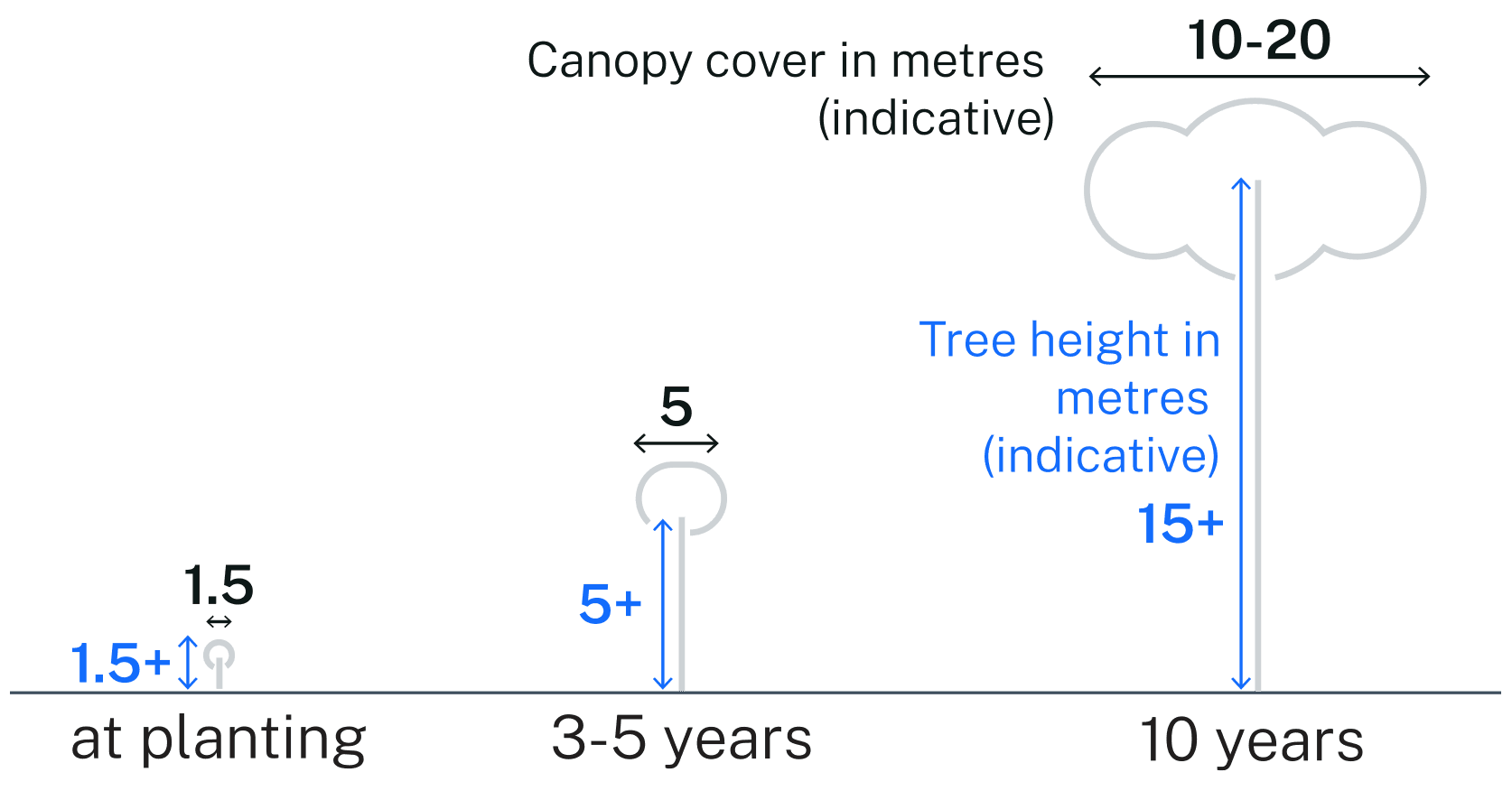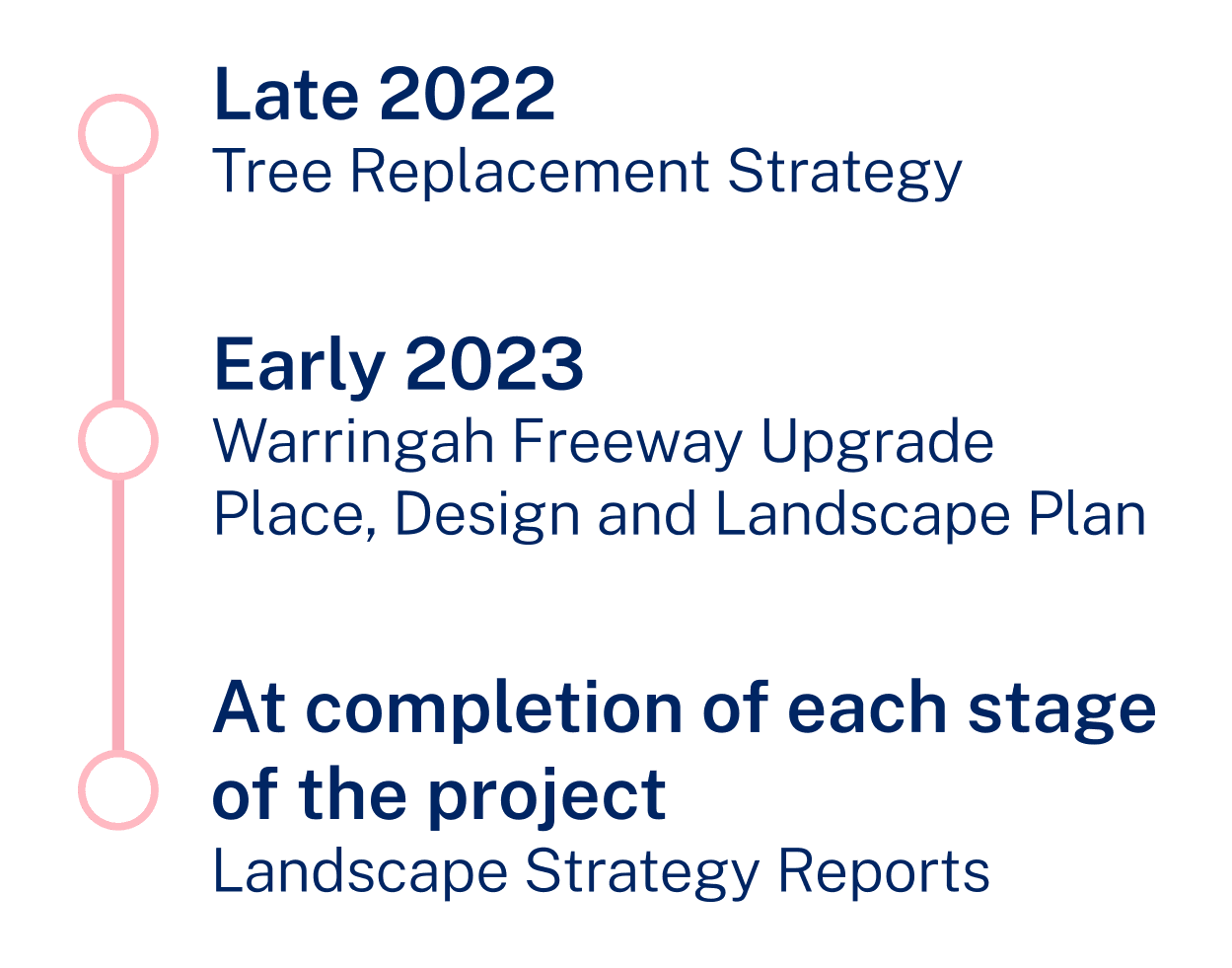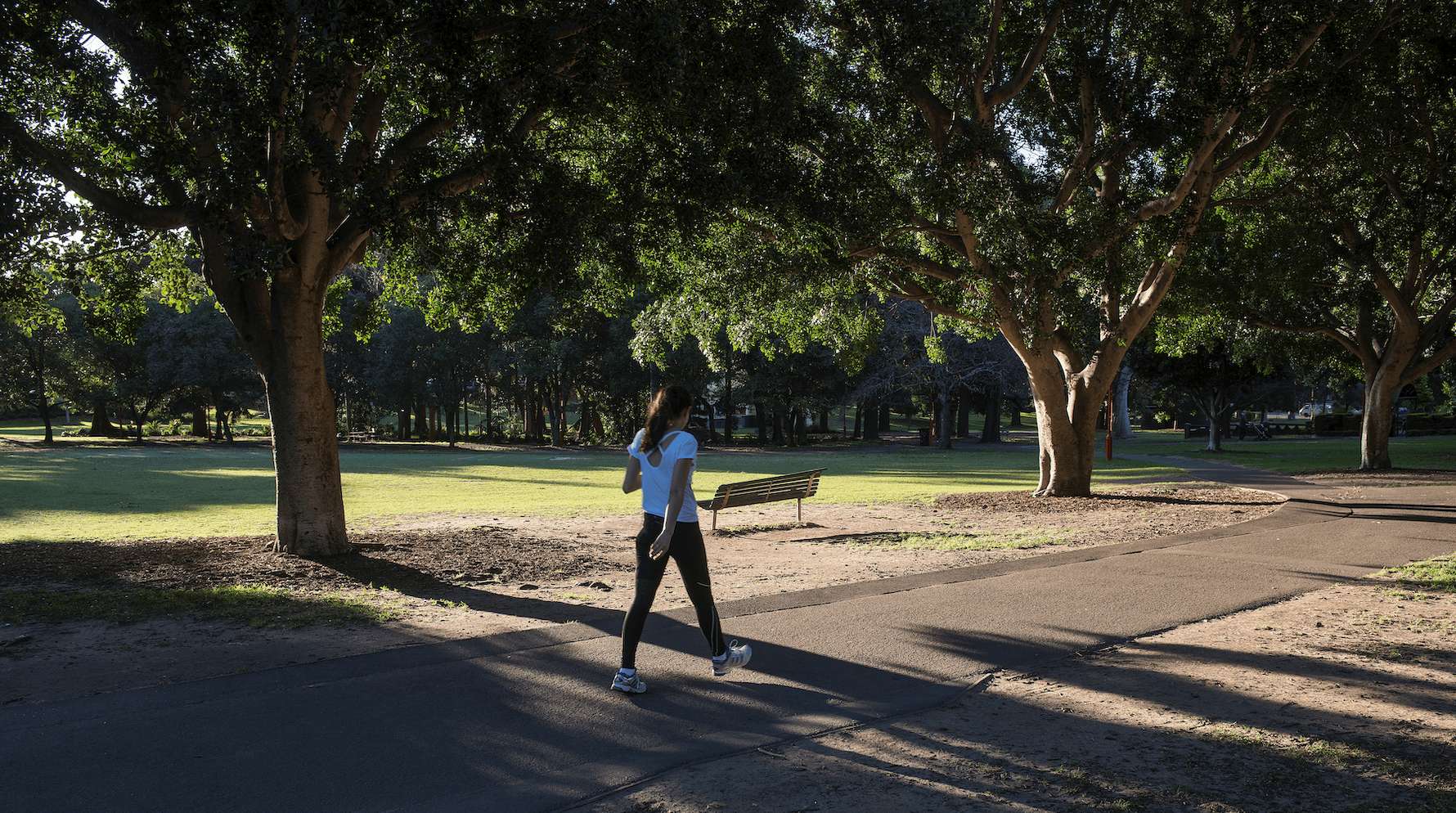Tree replanting and landscaping has begun
We understand trees are important to the community and acknowledge the impact the Warringah Freeway Upgrade and Western Harbour Tunnel projects have had on vegetation in our work areas. An important objective of both projects is to replace the trees that have been removed and improve the quality of canopy for North Sydney.
We have been working closely with North Sydney Council on how we will return trees and vegetation. This program of cooperation began through joint development of the strategy and continues now with the Tree Replacement Working Group. This cooperation, together with further community consultation, will continue as both projects progress and begin to wrap up.
We look forward to updating you on our progress throughout 2025.
Our approach to tree replacement
As the project continues, we are progressively replacing trees. The projects are in early stages of delivery and we are already engaging with tree nurseries around Greater Sydney who are capable of supplying us with replacement trees. This includes some common larger varieties typically growing within the project corridor.
A progressive tree replacement approach means that by the time the projects are delivered, replacement trees will have already grown to significant heights and canopy width to provide canopy coverage as well as visual screening along the project corridor.

Where have we planted so far?
We have already begun replanting trees and commenced landscaping on areas within the Warringah Freeway Upgrade project area.
This will continue progressively throughout both the Warringah Freeway Upgrade and Western Harbour Tunnel projects as each project completes work in a given area and no longer needs to disturb that location.
More trees in North Sydney
Transport recognises the value the North Sydney community places on its natural landscapes, heritage features and open space.
We are working with the local community, stakeholders and North Sydney Council to determine the best outcomes for replacement tree species, sizes and locations.
Under the planning approval conditions for the project, trees will be replaced at a ratio of two to one along the project area, with a net increase in tree canopy coverage.
Planning conditions define trees as ‘a long lived woody perennial plant greater than (or usually greater than) three metres in height with one or relatively few main stems or trunks’.
The Tree Replacement Strategy includes options for replacing trees in the North Sydney area in line with the planning conditions. These conditions mean that at the end of the project, there will be more trees in North Sydney and other areas than there were before.
Read the Tree Replacement Strategy by clicking the link below.

Fast fact – tree growth rates
Some of the trees we will select in consultation with the community and local Council are those already common in and around the project corridor and many common types are relatively fast growing trees.
The Sydney Blue Gum is a common tree type found in the project corridor. This species of tree can grow to a significant size in just a few years if planted in the right locations and properly cared for.
These trees and others expected to be used for tree replacement can grow even larger over the years, providing visual amenity for the community and cooler and greener places. We will work in partnership with North Sydney Council to determine a comprehensive list of species.

Community feedback
We are currently assessing land within and around the project areas for tree planting opportunities. Once studies have been completed and replanting proposals prepared, we will begin to consult with relevant stakeholders and community members. We will keep community informed of consultation opportunities for this.
Earlier consultation
From 7 December 2022 to 5 February 2023 we sought valuable feedback from the community on the Tree Replacement Strategy including locations for replacement trees, tree types, dimensions and species, including community views on tree replacement alternatives we may not have considered.

Find out more
For further general information, watch our Tree Replacement Strategy short video.
For information on replacement trees being ordered from tree nurseries, watch this video
For more information on tree replacement for the project, read our tree replacement fact sheet
For more information on how we protect and preserve tree, read our fact sheet on minimising impacts on trees.
Tree replacement and landscaping within the Place, Design and Landscape Plans
Place, Design and Landscape Plans have now been prepared for each project. These include the proposed tree replacement approach, landscaping and species types within the footprint of each project. Later in the project we will release Landscape Strategy Reports describing including details on the type, size, number and location of replacement trees.
For more information on the two project PDLPs, please view the "Landscape Design" chapter of each PDLP by clicking each button below:
Frequently asked questions – tree removal and replacement
For more information on common questions and answers about our tree replacement approach, please see our frequently asked questions.
In accordance with the planning approvals for the Western Harbour Tunnel and Warringah Freeway Upgrade project, we will replace all trees removed during the work. Given changes to the road corridor, we may need to replace trees in other locations. Our Minister's Condition of Approval require that we replant two trees for every one tree removed. This includes replacing trees in both the reconfigured Cammeray Golf Course and in the wider project footprint. Our tree replacement approach will meet project requirements with a considered approach to tree selection, replacement location and staging, with overarching objective of high-quality tree coverage in North Sydney.
As we begin to replant trees across project areas, you may notice that some plantings look sparse or small. A range of factors limit where and what we can plant within a given location, so it is important we use qualified landscape professionals to plan both species selection and the landscaping layout to ensure the plantings can flourish. Factors that may influence planting decisions include:
utilities such as cables or drainage being located just below the surface, limiting what can be planted in the shallow soil
the need to provide the plants with the required space for future growth. For example, Port Jackson Fig trees ultimately grow to provide a wide canopy, so can not be planted too close together.
younger trees are more adaptable and more likely to establish themselves than older, less pliable trees.
Over time, as the new plantings become established and begin to flourish, areas will begin to look greener and more dense.
Our Minister's Conditions of Approval require that we replace trees at a ratio of 2:1, with plantings both in and beyond the project boundary, helping to improve the urban canopy of the greater North Sydney LGA.
A range of factors may affect how many trees we can plant and what types of trees we can plant in a given location. These include:
new infrastructure elements, such as pavements or retaining walls, are now in that location, preventing any planting
the project may have added new utilities to the ground in that location, which limits the type of vegetation and root structures that can grow there
species selected for that location would ultimately grow to form a wide canopy, so in order for them to become established and grow to their full potential, they cannot be crowded out when first planted
the location was already planted to capacity prior to the projects starting work, so cannot support a 2:1 ratio of replacement trees.
Because of these factors, we also need to look for planting opportunities beyond the immediate project areas. Please be assured, however, that we are prioritising returning trees to the locations they were removed from and within the project area.
We are carefully planting trees with consideration for the local conditions and continuing environment, so while tree numbers are important, we also believe it is extremely important to plant with future growth in mind and with the important objective of improving the overall quality of North Sydney's green canopy.
The project involves the construction of a new motorway tunnel including harbour crossing from the Warringah Freeway at Cammeray to WestConnex at the Rozelle Interchange. It includes major upgrades, streamlining and new connections to the Warringah Freeway. The project has been designed to minimise impacts on trees, however, in order to construct the project some trees along the corridor need to be removed. These trees will be replaced at a ratio of two to one.
Our preference is to retain vegetation by redesigning construction work where possible or seeking qualified arborist advice to retain trees. This is common practice across infrastructure projects including the Western Harbour Tunnel and Warringah Freeway Upgrade projects where the design has been managed to avoid or reduce tree impacts. For example, in some underground utility relocation works for the Warringah Freeway, the design has been changed to avoid or reduce the need to impact tree roots.
Transport’s key aim in managing tree and vegetation impacts, is firstly to design the project to avoid or minimise the need to remove trees. If a tree does need to be removed during the work, it will be inspected by a qualified arborist including the location, size and type of tree. This will assist the project team in developing a tree replacement program that returns as many trees as possible in close proximity to their original locations, in keeping with the existing biodiversity of the project corridor.
Planning approvals for the project include a range of conditions relating to the impacts on trees and vegetation across the project alignment. A key requirement of the Minister’s Conditions of Approval (MCoA) is that the project “must be designed to retain as many trees as possible. Replacement trees and plantings must be provided at a ratio of 2:1 and deliver an increase in tree canopy to enhance the relevant council’s position in respect of the Sydney Green Grid, unless otherwise specified by the Planning Secretary”. The conditions also require that replacement trees must be planted within 500 metres of the project boundary on public land.
As part of the Infrastructure Approval (SSI-8863), the following definition of a tree was provided:
"Long lived woody perennial plant greater than (or usually greater than) 3 metres in height with one or relatively few main stems or trunks (AS4373-2007 Pruning of amenity trees)."
Trees selected for replanting for the project will comply with this definition.
As part of the development of the Tree Replacement Strategy, and the Place, Design and Landscape Plan, Transport is working to identify a range of open space options for tree replacement in the North Sydney area. We will work with the local community, stakeholders and North Sydney Council on a range of options along the project corridor and within the local government area designed to improve open space and create new green space for the community to enjoy.
We are seeking your feedback on the draft Tree Replacement Strategy. The draft strategy us on display from Wednesday 7 December 2022 until Sunday 5 February 2023. We are seeking your ideas on locations for tree replacement, the options we have identified, types of trees you value in the area and ideas on how the local community in the North Sydney area can be involved in tree planting activities.
As the project continues, we are progressively replacing trees along the project corridor. Our project teams will also start replacing trees in the newly reconfigured Cammeray Golf Course, before the end of 2022. A progressive tree replacement approach means that by the time the project is delivered, many of the replacement trees along the corridor will have achieved significant growth in both height and canopy width to provide canopy coverage as well as visual screening.
Our urban design, landscape advisory and project delivery teams will work with the local Council to identify a comprehensive list of replacement tree species. Common species that are likely to be used as replacement trees include the Sydney Blue Gum, the Broad-leaved Paperbark, the Smooth Barked Apple and the Melaleuca. We will work with Council and the community to ensure the right types and sizes of trees will be selected for the right location, to enhance green space and canopy cover for a cooler and greener North Sydney.
For more information on key aspects of the project including environmental and construction management on the project, including more details on trees, please visit our general Warringah Freeway Frequently Asked Questions and Western Harbour Tunnel Frequently Asked Questions page.
While feedback on the Tree Replacement Strategy closed in early 2023, we continue to welcome your input on revegetation opportunities in your area. To let us know your suggestions, please click here to complete this feedback form.
Working group meeting summaries
For enquiries on the Tree Replacement Strategy you can contact the project team directly via:
Phone: 1800 931 189
Email: whtbl@transport.nsw.gov.au


